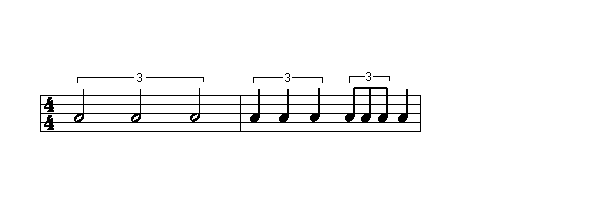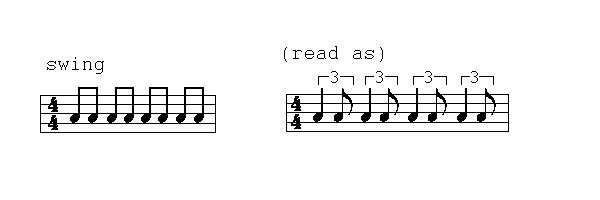Music-Crash-Course-Triplets-Swing-Tempo-Pulse
Contents
Triplets
The triplet is a musical symbol, which alters the time value of notes and rests. It says to the reader: "fit three time values of these notes and/or rests, into the same time value of two notes and/or rests".
In order to fit three into two, we divide 2 by 3; 2/3=.66
Each note and/or rest (member of a triplet group) has an value equal to .66 of it's original value.

Measure one contains one triplet group of three half notes.
In 4/4 time, two half notes equals 4 beats (2+2=4).
Each member of a triplet group has an equivalent beat time value equal to .66 of it's original value.
2 (the original beat value of a half note in 4/4 time) times .66 = 2 X .66 =1.33
1.33 + 1.33 + 1.33 = 4 beats (rounded to the nearest whole number).
The first two beats of measure two contains one triplet group of three quarter notes. The third beat contains one triplet group of three eighth notes. The fourth beat contains one quarter note.
((1 X .66) X 3) + ((.5 X .66) X 3) + 1 = 2+1+1 = 4 beats
Swing
Swing is a very useful form of "short hand" notation. Swing notation grew out of early American music and is widely used by jazz musicians. When "Swing" is indicated, the reader converts the first eighth note/rest (of each quarter note value) into two tied triplet eighth notes/rests and the second eighth note/rest into a single eighth note triplet. Only eighth notes (and eighth rests) are read differently in "swing", all other time values remain unchanged.
Here is a pattern of eighth notes in "swing" and as this pattern would be written without "swing" indicated. Instead of using two tied eighth note triplets, a quarter note, which has the same time value as two eighth notes with the triplet bracket, makes the notation clearer.

Tempo
Tempo describes the speed of the music. Sometimes this description is in very general terms (very fast, slowly, moderate etc.) However, the tempo is often expressed more explicitly with a simple equation, using a note and a number.
The note is a representation of a significant division of the measure, usually the beat of the time signature; the number is the how many of these divisions occur per minute. The number is often called bpm for 'beats per minute', however, that is not always exactly correct. The note is not always equivalent to the "beat" as defined by the time signature.
The basic form of a tempo marking is n=t (n = note ; t = bpm). Here are some examples of how tempo may be expressed.

Pulse
As humans we have an inherent ability to identify with even, steady, repetitive percussive sounds - Pulse; Some examples of "pulse" in music: Steps of a waltz, the bass drum of disco, foot tapping to a march, hand clapping of a gospel choir. The pulse of music is reflected in how music is written; Pulse also significantly influences which time signature is used for a particular piece of music.
The triplet is a musical symbol, which alters the time value of notes and rests. It says to the reader: "fit three time values of these notes and/or rests, into the same time value of two notes and/or rests".
In order to fit three into two, we divide 2 by 3; 2/3=.66
Each note and/or rest (member of a triplet group) has an value equal to .66 of it's original value.

Measure one contains one triplet group of three half notes.
In 4/4 time, two half notes equals 4 beats (2+2=4).
Each member of a triplet group has an equivalent beat time value equal to .66 of it's original value.
2 (the original beat value of a half note in 4/4 time) times .66 = 2 X .66 =1.33
1.33 + 1.33 + 1.33 = 4 beats (rounded to the nearest whole number).
The first two beats of measure two contains one triplet group of three quarter notes. The third beat contains one triplet group of three eighth notes. The fourth beat contains one quarter note.
((1 X .66) X 3) + ((.5 X .66) X 3) + 1 = 2+1+1 = 4 beats
Swing
Swing is a very useful form of "short hand" notation. Swing notation grew out of early American music and is widely used by jazz musicians. When "Swing" is indicated, the reader converts the first eighth note/rest (of each quarter note value) into two tied triplet eighth notes/rests and the second eighth note/rest into a single eighth note triplet. Only eighth notes (and eighth rests) are read differently in "swing", all other time values remain unchanged.
Here is a pattern of eighth notes in "swing" and as this pattern would be written without "swing" indicated. Instead of using two tied eighth note triplets, a quarter note, which has the same time value as two eighth notes with the triplet bracket, makes the notation clearer.

Tempo
Tempo describes the speed of the music. Sometimes this description is in very general terms (very fast, slowly, moderate etc.) However, the tempo is often expressed more explicitly with a simple equation, using a note and a number.
The note is a representation of a significant division of the measure, usually the beat of the time signature; the number is the how many of these divisions occur per minute. The number is often called bpm for 'beats per minute', however, that is not always exactly correct. The note is not always equivalent to the "beat" as defined by the time signature.
The basic form of a tempo marking is n=t (n = note ; t = bpm). Here are some examples of how tempo may be expressed.

Pulse
As humans we have an inherent ability to identify with even, steady, repetitive percussive sounds - Pulse; Some examples of "pulse" in music: Steps of a waltz, the bass drum of disco, foot tapping to a march, hand clapping of a gospel choir. The pulse of music is reflected in how music is written; Pulse also significantly influences which time signature is used for a particular piece of music.

